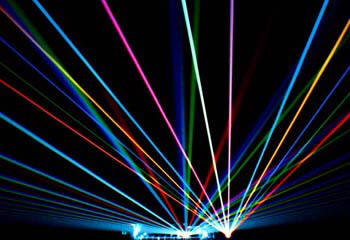

How it works
Lasers are a great way to add to any event; even a wedding. Lasers portray beams of light in many colors which could impress many of your guests. Laser shows are done with a variety of different lasers, and not all lasers work the same way. To show this, I will explain three different types of lasers: Ruby Laser, Three-level laser, and the Helium Neon laser.

An array of colorful beams - Photo by L.
Michael Roberts
Ruby Laser
Ruby lasers would be well known for their name
as they do project red light and a wavelength of 694nm. The ruby laser contains
of a flash tube, a ruby rod, and two mirrors, which one of the two mirrors is
half-silvered. To start the laser, the flash tube gives off light which is then
injected into the ruby rod. In doing this, the light then excites the atoms
within the ruby rod then making the atoms emit photons. The photons then begin
to move parallel to the that of the axis of the ruby rod. As the photons then
run back and forth, the bounce off the mirrors that are within the ruby rod. In
doing this they than begin to stimulate emission within the other atoms with the
rod. Then a single wavelength in color leaves the ruby rod through the
half-silvered mirror.
Diagram of Ruby Rod
Three-level Laser
The Three-level
Laser starts by pumping an electron to a higher, unstable
energy level. Since the electron was unstable, it is then quickly pumped down to
a slightly lower energy level. In doing this the electron relaxes and then
releases a photon. The photon that was released then collides with another
electron in an excited state which creates two photons at the same wavelength.
Then the photons are reflected off a mirror to produce its light.
Diagram of Three-level
Laser
Helium Neon Laser
Helium Neon
Lasers (HeNe) use the mixture of the gases helium and neon along with a source
that pumps an electrical discharge through an anode and cathode which are
situated at each end of a glass tube. Also at each end of the tube are two
mirrors (much like that of the Ruby Laser). When the discharge takes place it
excites the helium atoms to an excited state and then begin to collide with the
ground state neon atoms. As this action of colliding atoms of helium and neon
persist, they begin to create lots of energy that collides with the tubes walls
and in turn emit light. The HeNe lasers can emit colors of green (543.5nm),
yellow (594nm), and orange (612nm) according the different wavelengths and the
type of mirrors used.
More
information about the Helium Neon Laser
Colors of a Laser Show
The charts shown below help to explain more
about the colors given off by different types of lasers. The
laser line chart, on the
bottom left, shows at what wavelengths each color emits its light with different
types of lasers. The chart that is on the bottom right shows how light is
emitted through a laser
projector. The laser projector is only a small part of a full system called
the laser light show
system. In this system, you can find other major sub-systems that help to
create the laser shows besides that of the laser projector.


This page is not that of a real company but is for a chemistry assignment for General Chemistry 140 at Monmouth College